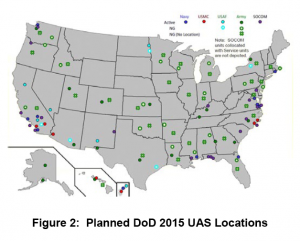
An Mi-17 undergoing maintenance. Most maintenance within SMW is carried out by contractors because SMW lacks the expertise. (SIGAR photo).
The Special Inspector General for Afghanistan Reconstruction, (SIGAR) issued a report (pdf) yesterday that serves as microcosm of the bumbling ineptitude and denial of reality that has characterized the entire US military’s misadventure in Afghanistan. Subtexts running through this scandal run the gamut from US think tanks cooking up unworkable plans to the vast network of international arms dealing (replete with counterfeit parts), Russia supplying arms to Syria, possible blow-back from the arrest of Viktor Bout, the US Congress remarkably trying to exert a bit of power and finally DoD declaring that they will continue with their schedule for claiming Afghanistan can provide its own defense operations despite overwhelming evidence to the contrary.
At issue here primarily is a contract for 30 Russian Mi-17 helicopters. Despite the fact that the US has been at war in Afghanistan continuously for almost twelve years now, and despite the spectacular failure of US helicopters under haboob (dust storm) conditions in the failed April, 1980 Iran hostage rescue attempt, it appears that Russian helicopters are more reliable in desert conditions and easier to maintain in flying order with a less sophisticated ground crew than US helicopters
The route by which we got to this contract is remarkable. The helicopters are to be supplied to the Special Mission Wing, which is the air support group for Afghanistan’s Special Operations forces. But how this group came into existence is very important to the current scandal. From the report (footnotes removed in this and all subsequent quotes):
At a December 2011 Special Operations Summit, ISAF senior leadership identified the development of air support capacity as a priority for improving Afghan military capabilities for counterterrorism and other special operations missions. To respond to this need, NTM-A [NATO Training Mission – Afghanistan] sponsored a RAND study to assess requirements and provide recommendations. The study’s recommendations discussed different scenarios for the planned size—in terms of both personnel and aircraft—of air support, the command structure, and scope of operations.
NTM-A determined that the Afghan Ministry of Interior’s (MOI) existing Air Interdiction Unit, a counternarcotics-focused unit, would provide the best foundation to develop an Afghan counterterrorism and special operations aviation capability, while maintaining critical counternarcotics efforts. On May 12, 2012, NTM-A issued a military order identifying its concept for the establishment of the SMW. On July 18, 2012, the ANA commissioned the SMW, which replaced the Air Interdiction Unit.
That’s all fine and dandy, except that the geniuses at RAND didn’t allow for the fact that they created a destructive turf war inside the Afghan government. The new SMW is to be housed within Afghanistan’s Ministry of Defense (MOD) since that is where Afghan Special Operations resides. The turf war over moving the existing unit has not yet been resolved:
Ongoing tensions between the MOI and MOD over administrative control of the SMW also impacts recruitment. The NTM-A concept calls for the transfer of SMW from joint MOI/MOD to strictly MOD command and control. The ETT [Embedded Training Team] Commander pushed the Afghan government to make the transition by January 2013—although it did not happen—because he believes the transition will allow the SMW to leverage the recruiting efforts and resources of the Afghan Air Force. The Afghan government has generated a draft memorandum of understanding between MOI and MOD to transfer the command authority of the SMW to the MOD. The memorandum states that, effective upon publication, the ministries agree the SMW will fall under the command authority of the MOD and be assigned to the ANA Special Operations Command. Nevertheless, the memorandum is still in draft form and remains unsigned by the ministries due largely to MOI resistance to surrendering authority over the SMW.
Further, according to the ETT Commander, the MOD is unwilling to allow SMW recruitment from its ranks without assurances that the pilots, once trained, will remain under its control. The ETT Commander stated that he expects recruitment to improve when the two ministries agree on the planned memorandum of understanding that completes the SMW’s transition tothe MOD.
The impact on recruitment? It’s huge, and is the primary reason SIGAR advocated for suspending the planned purchase of aircraft (emphasis added):
The SMW lacks the capacity—both in personnel numbers and expertise—to operate and maintain its current and planned fleets, and NTM-A and DOD do not have personnel or performance milestones requiring the SMW to develop the necessary capacity before DOD acquires and delivers the full complement of aircraft for the SMW at a cost of $771.8 million for 30 new Mi-17s and 18 PC-12s. The NTM-A concept of operations calls for an SMW comprising 806 personnel at full strength, and DOD officials call for the SMW to have full operational capability by July 2015. However, as of January 23, 2013, the ETT Commander confirmed that the SMW had just 180 personnel—less than one quarter of the personnel necessary to meet full operational capacity.
The whole concept of purchasing Russian-made helicopters is quite controversial now, especially since the very supplier under discussion here, Rosoboronexport, has been accused of supplying arms to Syria (see, for example, this GAO report-pdf). In fact, the SIGAR report states:
Specifically, under the fiscal year 2013 National Defense Authorization Act, Congress prohibited contracting with Rosoboronexport.
On June 3, SIGAR provided a draft version of the report to the Defense Department, recommending that the purchase of aircraft for SMW be suspended until staffing and training reached a point that the aircraft could be used in missions and properly maintained. Despite that recommendation, and despite the NDAA ban on purchases from Rosoboronexport, the Defense Department entered into the final contract with Rosoboronexport on June 16.
The end-run around NDAA is especially enraging. The sentence above about the 2013 NDAA prohibiting contracting with Rosoboronexport in the report is followed by this one:
However, by using fiscal year 2012 funds for the award, DOD concluded that it was legally able to proceed with this purchase.
What a wonderful, upstanding operation our Defense Department is.
Postscript: If the follies above aren’t enough to set your blood boiling, consider that the contract for maintenance, logistics and spare parts for the aircraft assigned to SMW is split in an unbelievable way between two huge defense contractors:
Our audit focuses on these two large task orders that provide ongoing aircraft maintenance and logistical support services. Specifically, the U.S. Army Space & Missile Defense Command awarded:
• Task order 20 on September 26, 2008, to Northrop Grumman to provide maintenance and logistics support services for Afghan MOI and MOD air assets, as well as training for Afghan pilots, flight engineers, and mechanics. As of April 4, 2013, the amount obligated was approximately $364.6 million, with approximately $50.7 million supporting the SMW since its inception in July 2012.
• Task order 32 on September 30, 2009, to Lockheed Martin Integrated Systems, Inc. for procurement of materiel and spare parts in support of MOI and MOD air maintenance and repair options. As of February 21, 2013, the total obligated amount on task order 32 was approximately $407.1 million, with approximately $71.2 million supporting the SMW since its inception.
Coordination between the two contractors is necessary to maintain efficiency since one contractor maintains the aircraft and identifies parts requirements, and the other contractor actually orders the parts. Contractors perform their maintenance and logistics functions at the Kabul International Airport and store spare parts and supplies at a warehouse there (see photo 2). Task orders 20 and 32 each provide services for both the MOI and the MOD; however, each task order lists the services for each ministry separately and the contractors have separate teams supporting each ministry. Services to support the SMW fall under the MOI task order line items.
What could possibly go wrong?

